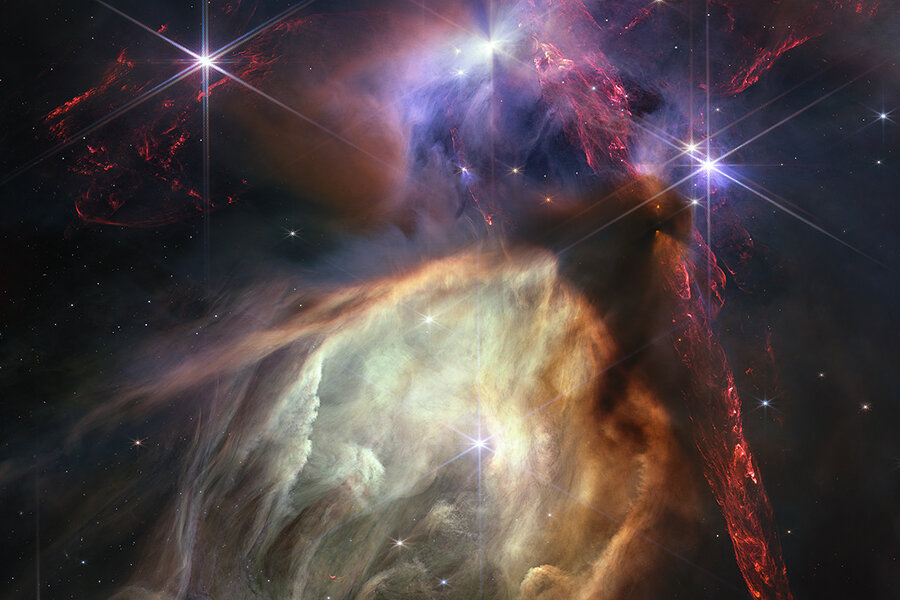In with a bang: The James Webb Space Telescope after one year
Loading...
The pictures have amazed the world. They are also expanding the horizons of science. NASA’s James Webb Space Telescope (JWST) is special because it is larger and more powerful than its predecessors. It can excel at spectroscopy, the measurement of light wavelengths, which helps reveal physical details like a celestial object’s temperature, age, and speed – and even what the object is made of.
“The joke in the community ... is that a picture says a thousand words, but a spectrum is worth a thousand pictures,” says Massimo Stiavelli, mission leader for the telescope.
Why We Wrote This
A story focused onFrom its first images, the James Webb Space Telescope has delivered breathtaking views of our universe. The range and precision of its observations are also transforming science.
Perhaps the greatest surprise so far is that the earliest galaxies were bigger, brighter, and hotter than scientists had predicted.
In addition to viewing distant galaxies, the JWST is also adept at observing planets outside of our solar system, called exoplanets, seen as key to the search for other life in the universe. The telescope’s capacity to observe infrared light can unveil properties of exoplanet atmospheres.
“Is JWST going to give us a definitive ‘No, we’re not alone’? I don’t know,” says Cornell University astronomer Nikole Lewis. “But it’s certainly going to teach us a lot about how to look for life beyond our solar system.”
On the evening of July 11, 2022, U.S. President Joe Biden tweeted a photo. Points of orange, blue, and gold light sparkled and swirled against the black vacuum of space. It was our universe viewed through a new lens.
The image was the first from NASA’s James Webb Space Telescope (JWST), which has been heralded as a major step in the study of the cosmos.
“The first image from the Webb Space Telescope represents a historic moment for science and technology. For astronomy and space exploration,” Mr. Biden’s tweet read. “And for America and all humanity.”
Why We Wrote This
A story focused onFrom its first images, the James Webb Space Telescope has delivered breathtaking views of our universe. The range and precision of its observations are also transforming science.
That photo was soon followed by countless more, each as enthralling as the last. But the photos alone, though dazzling, don’t capture the scientific advances that this successor to the Hubble Space Telescope has already enabled in its first year – or those on the horizon.
“It’s transformational,” John Mather, a senior astrophysicist at NASA, says. “We expect that every page of the new astronomy textbooks will be different because of what we’ve found.”
How does the JWST enable new views of space?
This is a larger, more powerful telescope than its predecessors.
While the Hubble was primarily an imaging telescope, the JWST has a size that allows it to specialize in spectroscopy – the measurement of light in terms of its wavelength. When it comes to astronomy, spectroscopy can reveal many physical details about a celestial object: its temperature, its age, what it’s made of, and how fast it’s moving, for instance.
“The joke in the community ... is that a picture says a thousand words, but a spectrum is worth a thousand pictures,” says Massimo Stiavelli, mission leader for the telescope, which NASA developed with contributions from the European and Canadian space agencies.
Another distinctive feature of the telescope is its capacity to observe light in the infrared range. As a result, it can see objects that are more distant, those obscured by dust clouds, or those that emit only infrared radiation.
A predecessor, Spitzer, was also primarily an infrared telescope, but the much greater size of the JWST means that it can see farther and produce a sharper resolution. This, paired with its spectroscopy prowess, “makes it a completely different machine,” Dr. Stiavelli says.
The impressive size of the JWST’s mirror – with a light-collecting area six times that of the Hubble’s – is made possible by a unique design: It is actually made of 18 smaller mirrors that unfurl to form a monolithic mirror after the telescope’s launch.
What have been its biggest Year 1 discoveries?
Perhaps the greatest surprise so far is that the earliest galaxies were bigger, brighter, and hotter than scientists had predicted.
“We don’t know what the reason is,” Dr. Mather says. “It could be something is weird about the way stars grow. It could be that the early universe is just different enough that we have no idea we missed something. It’s even conceivable that there are weird things about the expansion [of the universe] itself.”
Observations made with the telescope have also offered hints about what Dr. Stiavelli calls “kind of the holy grail of JWST”: population III stars.
These are stars composed only of hydrogen and helium – the elements that physicists say made up the universe after the Big Bang. Population III stars, although not yet conclusively observed, have been proposed as a likely breeding ground for the formation of the other, heavier elements found in stars like our sun, in planets, and even in human beings.
Some observers have argued that they’ve seen evidence of population III stars with the JWST. “It’s very interesting that we see this” high-energy radiation, says Dr. Stiavelli. Still, he maintains a dose of skepticism, citing other possible explanations, such as black holes.
Can the JWST help find life out there?
In addition to distant galaxies, the JWST is also adept at observing planets outside of our solar system, called exoplanets, seen as key to the search for other life in the universe. In particular, the telescope has enabled scientists to analyze many more exoplanets using light in the infrared range.
“The infrared is very, very rich for studying little fingerprints of things,” says Nikole Lewis, a Cornell University astronomer who specializes in exoplanets, “like water and carbon dioxide, and methane and carbon monoxide, and various types of what we call aerosols – clouds and hazes.”
“We, the exoplanet community, are like kids in a candy shop right now,” she adds.
An especially significant discovery was the existence of carbon dioxide in “hot Jupiters,” gas giants that are warmer than those in our solar system. This was at odds with what models had predicted.
“Right now, we’re going through the process of learning about these planets and their atmospheres, and then having to rapidly adapt all of our theories, which have basically been wrong,” Dr. Lewis says. “So that’s been one of the big transformational things, I think, across the board – not only for exoplanets – JWST is really pushing the limits of our theories, and pushing them forward.”
What might come next?
First in the near future may be further discoveries that follow from the telescope’s early results.
“We are on the verge of a major step in understanding in a lot of areas,” says Dr. Stiavelli, pointing in particular to the advances already underway in galaxy and star formation.
There are still other areas where, despite a lack of major advances so far, scientists have reason to anticipate fresh fireworks.
One is “cosmological tension,” which is how scientists characterize attempts to measure the expansion rate of the universe. Different forms of measurement give different results for what’s known as the Hubble constant, the unit of measurement that aims to pin down precisely how fast the universe is expanding.
A number of researchers are using the JWST to refine their measurements of this constant. Based on whether or not it corresponds to previous measurements, a result here could provide further evidence that the tension is a genuine problem, or help resolve it.
Within the field of exoplanet research, much of the focus is on scientists who are trying to measure the atmosphere of rocky exoplanets, similar to Earth. To date, no rocky exoplanet has been confirmed to have an atmosphere.
A result in this area would be a crucial step in the search for other life-forms.
“Is JWST going to give us a definitive ‘No, we’re not alone’? I don’t know,” Dr. Lewis says. “But it’s certainly going to teach us a lot about how to look for life beyond our solar system.”











